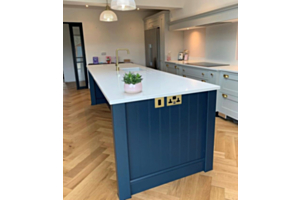When it comes to transforming the look and feel of your home, few upgrades are as impactful as new wood flooring. With a plethora of options available, making the right choice can be overwhelming. This ultimate guide will help you navigate through the different types of wood flooring, their benefits, and key considerations for selecting the perfect flooring for each room in your house.
Types of Wood Flooring
1. Solid Hardwood Flooring
Solid hardwood is crafted from a single piece of wood. It’s available in various species, including oak, maple, cherry, and walnut.
Benefits:
- Durability: Can last for decades with proper care.
- Refinishing: Can be sanded and refinished multiple times.
- Aesthetic Appeal: Offers a timeless and natural beauty.
Best For: Living rooms, dining rooms, and bedrooms due to its classic look and durability.
2. Engineered Wood Flooring
Engineered wood consists of a top layer of real wood veneer bonded to multiple layers of plywood. This construction enhances stability and resistance to moisture.
Benefits:
- Stability: Less prone to warping and swelling.
- Versatility: Can be installed over concrete and radiant heating systems.
- Cost: Generally more affordable than solid hardwood.
Best For: Basements, kitchens, and bathrooms, where moisture levels fluctuate.
3. Laminate Wood Flooring
Laminate is a synthetic flooring product that mimics the appearance of real wood through a high-resolution image layer topped with a protective coating.
Benefits:
- Affordability: Cheaper than hardwood and engineered wood.
- Durability: Resistant to scratches, dents, and stains.
- Easy Installation: Often features a click-lock system for DIY installation.
Best For: High-traffic areas like hallways and entryways due to its durability and cost-effectiveness.
4. Bamboo Flooring
Bamboo is technically a grass but is manufactured to create hard, wood-like flooring.
Benefits:
- Eco-Friendly: Renewable and sustainable resource.
- Hardness: Comparable to hardwood, with some types being even harder.
- Unique Look: Offers a distinct and modern aesthetic.
Best For: Living rooms and bedrooms, where its unique look can be showcased.
5. Reclaimed Wood Flooring
Reclaimed wood is salvaged from old buildings, barns, and factories, repurposed for new flooring.
Benefits:
- Sustainability: Environmentally friendly, reducing the need for new timber.
- Character: Rich with history, offering a unique and rustic appearance.
- Durability: Often harder and more stable due to its age.
Best For: Any room where you want to add character and charm, especially living rooms and bedrooms.
Key Considerations for Selecting Wood Flooring
1. Room Function and Traffic
- High-Traffic Areas: Consider laminate or engineered wood for durability.
- Moisture-Prone Areas: Opt for engineered wood or bamboo to resist moisture damage.
- Low-Traffic Areas: Solid hardwood is ideal for spaces like bedrooms and formal living rooms.
2. Subfloor Type
- Concrete Subfloors: Engineered wood and laminate are suitable due to their moisture resistance.
- Wood Subfloors: Solid hardwood and engineered wood are both viable options.
3. Installation Method
- DIY Installation: Laminate with click-lock systems is the easiest for DIY projects.
- Professional Installation: Solid hardwood often requires professional installation due to the need for nailing and sanding.
4. Aesthetic Preferences
- Natural Look: Solid hardwood and engineered wood offer the most authentic wood appearance.
- Modern Style: Bamboo and laminate can provide a contemporary look with a wide range of finishes and colors.
5. Budget
- High-End Budget: Solid hardwood and reclaimed wood are premium choices.
- Moderate Budget: Engineered wood offers a balance of cost and quality.
- Budget-Friendly: Laminate is the most affordable option, providing great value for money.
6. Maintenance and Longevity
- Refinishing Needs: Solid hardwood can be refinished multiple times, extending its lifespan.
- Low Maintenance: Laminate and engineered wood require less upkeep and are more resistant to daily wear and tear.
Conclusion
Choosing the right wood flooring for your home involves understanding the various types available, their unique benefits, and how they align with your specific needs and preferences. By considering factors such as room function, subfloor type, installation method, aesthetics, budget, and maintenance, you can select the perfect wood flooring that will enhance the beauty, comfort, and value of your home for years to come. Please give one of our flooring experts at the Timber living Company a call on 01234 395934 for any advice.

